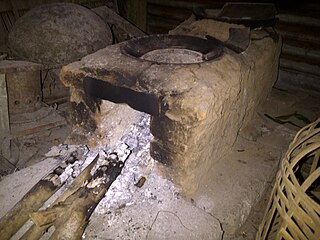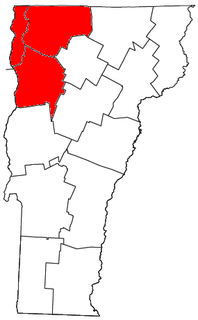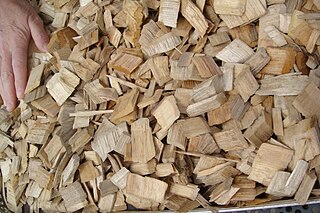Related Research Articles

Essex is the second most populous incorporated area in Chittenden County and the entire state of Vermont, United States, with the first being Burlington at 42,545, according to the 2020 U.S. census. As of the 2020 Census, the population of Essex was 22,094. The village of Essex Junction is located within the town, and that village is home to the state of Vermont's busiest Amtrak station and largest private employer, GlobalFoundries. Vermont Route 289 crosses the town from east to west.

Solid fuel refers to various forms of solid material that can be burnt to release energy, providing heat and light through the process of combustion. Solid fuels can be contrasted with liquid fuels and gaseous fuels. Common examples of solid fuels include wood, charcoal, peat, coal, hexamine fuel tablets, dry dung, wood pellets, corn, wheat, rye, and other grains. Solid fuels are extensively used in rocketry as solid propellants. Solid fuels have been used throughout human history to create fire and solid fuel is still in widespread use throughout the world in the present day.

A stove is a device that burns fuel or uses electricity to generate heat inside or on top of the apparatus. It has seen many developments over time and serves the main purpose of cooking food.

Wood fuel is a fuel such as firewood, charcoal, chips, sheets, pellets, and sawdust. The particular form used depends upon factors such as source, quantity, quality and application. In many areas, wood is the most easily available form of fuel, requiring no tools in the case of picking up dead wood, or few tools, although as in any industry, specialized tools, such as skidders and hydraulic wood splitters, have been developed to mechanize production. Sawmill waste and construction industry by-products also include various forms of lumber tailings.

Panicum virgatum, commonly known as switchgrass, is a perennial warm season bunchgrass native to North America, where it occurs naturally from 55°N latitude in Canada southwards into the United States and Mexico. Switchgrass is one of the dominant species of the central North American tallgrass prairie and can be found in remnant prairies, in native grass pastures, and naturalized along roadsides. It is used primarily for soil conservation, forage production, game cover, as an ornamental grass, in phytoremediation projects, fiber, electricity, heat production, for biosequestration of atmospheric carbon dioxide, and more recently as a biomass crop for ethanol and butanol.

Pellet fuels are biofuels made from compressed organic matter or biomass. Pellets can be made from any one of five general categories of biomass: industrial waste and co-products, food waste, agricultural residues, energy crops, and untreated lumber. Wood pellets are the most common type of pellet fuel and are generally made from compacted sawdust and related industrial wastes from the milling of lumber, manufacture of wood products and furniture, and construction. Other industrial waste sources include empty fruit bunches, palm kernel shells, coconut shells, and tree tops and branches discarded during logging operations. So-called "black pellets" are made of biomass, refined to resemble hard coal and were developed to be used in existing coal-fired power plants. Pellets are categorized by their heating value, moisture and ash content, and dimensions. They can be used as fuels for power generation, commercial or residential heating, and cooking. Pellets are extremely dense and can be produced with a low moisture content that allows them to be burned with a very high combustion efficiency.

A pellet stove is a stove that burns compressed wood or biomass pellets to create a source of heat for residential and sometimes industrial spaces. By steadily feeding fuel from a storage container (hopper) into a burn pot area, it produces a constant flame that requires little to no physical adjustments. Today's central heating systems operated with wood pellets as a renewable energy source can reach an efficiency factor of more than 90%.

Improved cook stoves (ICS) are biomass stoves that are intended to replace traditional cook stoves and open fires, in the context of energy poverty and cooking. As of 2020, more than 2.6 billion people in developing countries lack access to clean, modern fuel and technologies for cooking, and therefore rely on burning polluting fuels such as wood, animal dung, coal, or kerosene for cooking.

Lucius Eugene Chittenden was a Vermont author, banker, lawyer, politician and peace advocate who served as Register of the Treasury during the Lincoln administration.

Biomass heating systems generate heat from biomass.
The systems fall under the categories of:

Household air pollution (HAP) is a significant form of indoor polluted air mostly relating to cooking and heating methods used in developing countries.

The Burlington metropolitan area is a metropolitan area consisting of the three Vermont counties of Chittenden, Franklin, and Grand Isle. The metro area is anchored by the principal cities of Burlington, South Burlington, St. Albans and Winooski; the towns of Colchester, Essex and Milton; and the village of Essex Junction. According to 2012 U.S. Census estimates, the metro area had an estimated population of 213,701, approximately one third of Vermont's total population.

Woodchips are small- to medium-sized pieces of wood formed by cutting or chipping larger pieces of wood such as trees, branches, logging residues, stumps, roots, and wood waste.

The government of Vermont is a republican form of government modeled after the Government of the United States. The Constitution of Vermont is the supreme law of the state, followed by the Vermont Statutes. This is roughly analogous to the Federal United States Constitution, United States Code and Code of Federal Regulations respectively. Provision is made for the following frame of government under the Constitution of the State of Vermont: the executive branch, the legislative branch, and the judicial branch. All members of the executive and legislative branch serve two-year terms including the governor and senators. There are no term limits for any office.
Pellet Fuels Institute (PFI) is a North American trade organization that represents manufacturers, retailers and distributors of wood pellet fuel supplies and appliances. The PFI was formed in 1985 as the Fiber Fuels Institute.
Maine Energy Systems (MESys) was founded in summer 2008 by Les Otten, Dutch Dresser, and others to aid in the transition to alternative energy in the northeastern United States. The company delivers wood pellets in bulk and sells fully automated wood pellet boilers for hydronic heating. MESys has been involved in numerous academic studies, work with political groups concerned with the environmental and economic aspects of residential and light commercial heating, and works with American regulatory bodies concerned with the safety of heating appliances.
The waterside hot water hay pellet furnace is technology that was developed to convert grass and hay into energy that can used in home heating, also known as grass pellet heating.
Inbicon is a Danish company that produces cellulosic ethanol.

Thomas J. Donovan Jr. is an American lawyer and politician serving as Vermont Attorney General since 2017. He was first elected in 2016 with over 66 percent of the vote. He previously served for ten years as State's Attorney of Chittenden County, the most populous county in Vermont.

One aspect of energy poverty is lack of access to clean, modern fuels and technologies for cooking. As of 2020, more than 2.6 billion people in developing countries routinely cook with fuels such as wood, animal dung, coal, or kerosene. Burning these types of fuels in open fires or traditional stoves causes harmful household air pollution, resulting in an estimated 3.8 million deaths annually according to the World Health Organization (WHO), and contributes to various health, socio-economic, and environmental problems.
References
- ↑ "Archived copy". www.sustainableheatingvt.org. Archived from the original on February 7, 2019. Retrieved January 13, 2022.
{{cite web}}: CS1 maint: archived copy as title (link) - ↑ https://docs.google.com/present/view?skipauth=true&browserok=true&id=dd3n93t4_36q3q6k9 [ dead link ]
- ↑ http://www.town.williston.vt.us/website/images/documents/Selectboard/agenda2010/ag011110/biomass_resolution.pdf [ dead link ]
- ↑ http://www.town.williston.vt.us/website/images/documents/Selectboard/agenda2010/ag011110/biomass_resolution.pdf [ dead link ]
- ↑ "Archived copy". www.sustainableheatingvt.org. Archived from the original on November 7, 2016. Retrieved January 13, 2022.
{{cite web}}: CS1 maint: archived copy as title (link) - ↑ http://www.addisonindependent.com/201002vermonters-pull-together-cold-weather [ dead link ]